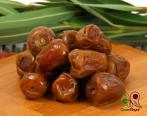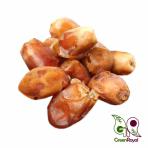Selling Fresh Yellow Dates in Large Quantities
What you will read in this article....
5 Wonderful Benefits of Yellow Datesthe Differece Between Yellow Barhi with Other Datesthe Conditions of Preserving Yellow DatesWhen Buying Date, Consider 3 PointsDistributing yellow Dates in Different PackingProducing Yellow Dates VarietiesBuying Yellow Dates at the Good PriceThe yellow dates is the fruit of the date palm. This is an energy fruit grown primarily in the Middle East. There are many varieties of dates. They are eaten fresh, like fresh fruit, dry syrup or cream. Also, use fresh dates for prepping your meats, your couscous, your bread and muffins, not to mention the famous date squares. So yellow dates have a lot of sales in that area.
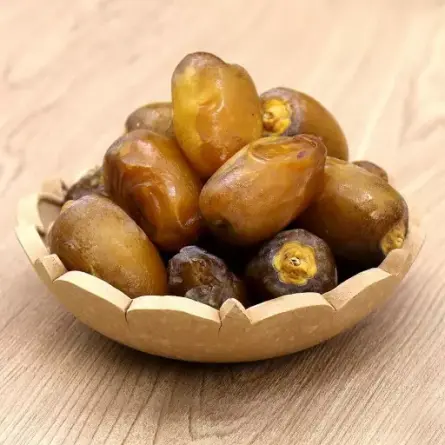
5 Wonderful Benefits of Yellow Dates
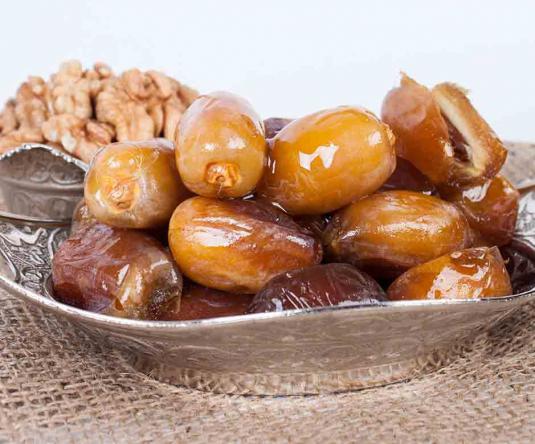 Dates benefits in health:
Dates benefits in health:
- High in polyphenols and antioxidants: Polyphenols are antioxidant compounds that can protect the body from inflammation. Dates contain more polyphenols than most other fruits and vegetables.In addition to their vitamin and mineral content, dates are rich in health protective antioxidants. One recent paper, published in the Journal of Pharmacy & BioAllied Sciences, states that dates are a good source of natural antioxidants, which can be used for the management of oxidative stress–related illnesses. Oxidative stress occurs when there is an imbalance between the production of cell-damaging free radicals and the body’s ability to counter their harmful effects. It’s a precursor to aging and cell damage that can lead to disease. Dates also contain anti-inflammatory and antimicrobial compounds, which means they may also play a role in combating infectious diseases. Other research has shown that dates contain many antioxidants, including carotenoids, polyphenols (e.g., phenolic acids, isoflavons, lignans, and flavonoids), tannins, and sterols. They also possess anti-fungal properties. Other antioxidants available on date are: Flavonoids: Flavonoids are powerful antioxidants that may help reduce inflammation and have been studied for their potential to reduce the risk of diabetes, Alzheimer’s disease and certain types of cancer. Carotenoids: Carotenoids are proven to promote heart health and may also reduce the risk of eye-related disorders, such as macular degeneration Phenolic acid: Known for its anti-inflammatory properties, phenolic acid may help lower the risk of cancer and heart disease.
- Alternative to empty-calorie sweets: Dates can satisfy a person’s sweet tooth while also providing essential nutrients, such as vitamin B-6 and iron. Three dates provide about 200 calories, 54 grams of carbohydrates with about 5 grams as fiber, a gram of protein, and no fat. There is 400calories in 2 dates. This size portion also supplies smaller amounts of a wide range of nutrients, including B vitamins, vitamin K, calcium, iron, magnesium, potassium, zinc, and manganese. In other words, dates aren’t simply sugar bombs or empty calories. Many people think of dates as dried fruit—but they’re actually fresh fruit, since no water is removed. And because dates are whole, unprocessed fruit, their sugar content is naturally occurring. In other words, if an energy bar is sweetened only with dates, the label can list 0 grams of added sugar. That’s key, because added sugar is the type we should limit, due to its association with an increased risk of heart disease and obesity. The American Heart Association (AHA) recommends that women consume no more than six teaspoons of added sugar per day, which equates to 25 grams or 100 calories. The advised cap for men is nine teaspoons of added sugar, which is 36 grams or 150 calories. If you use dates to sweeten a meal or recipe, you haven’t used up any of your daily added sugar budget, unlike sweeteners such as cane sugar.
- High in fiber. Just ¼ of a cup of dates provides 12 percent of a person’s daily fiber requirement. Fiber helps a person feel fuller for longer. Dates have an excellent nutrition profile. Since they’re dried, their calorie content is higher than most fresh fruit. The calorie content of dates is similar to that of other dried fruits, such as raisins and figs (1). Most of the calories in dates come from carbs. The rest are from a very small amount of protein. Despite their calories, dates contain some important vitamins and minerals in addition to a significant amount of fiber. Getting enough fiber is important for your overall health. With almost 7 grams of fiber in a 3.5-ounce serving, including dates in your diet is a great way to increase your fiber intake. Fiber can benefit your digestive health by preventing constipation. It promotes regular bowel movements by contributing to the formation of stool. In one study, 21 people who consumed 7 dates per day for 21 days experienced improvements in stool frequency and had a significant increase in bowel movements compared to when they did not eat dates. Furthermore, the fiber in dates may be beneficial for blood sugar control. Fiber slows digestion and may help prevent blood sugar levels from spiking too high after eating. For this reason, dates have a low glycemic index (GI) which measures how quickly your blood sugar rises after eating a certain food.
- High in potassium: Dates are high in potassium, which is an electrolyte the body needs for good heart health. Potassium also helps to build muscle and proteins in the body. One additional potential benefit of dates applies specifically to pregnant women. A 2020 paper, published in the journal BMC Pregnancy and Childbirth, looked at the impact of dates on labor and delivery. Researchers reviewed previously published studies and concluded that eating dates may reduce the duration of the active phase of labor, the stage during which the cervix dilates. It may also improve bishop score, a measure that rates the readiness of the cervix for vaginal labor.
- Great for substitutions: People can replace the sugar, chocolate chips, or candies in baking recipes with dates to ensure they are eating natural sugars instead of refined sugars. The many health benefits of eating dates include constipation relief, regulating cholesterol levels ,intestinal disorders, heart problems, anemia and sexual dysfunctions. Dates also contain isoflavones that are known to reduce the risk of cardiovascular disease. Dates contain no cholesterol.
the Differece Between Yellow Barhi with Other Dates
Barhi or Barhee is one of the most famous date types, which has thick flesh and rich flavor. It is more delicious when eaten fresh rather than dried. They are smaller and more spherical than other varieties and are often still attached to the vine when sold in their unripe, yellow stage. The Barhi, or Barhee, date comes from the date palm botanically classified as Phoenix dactylifera, and is considered the sweetest and creamiest of its species. In general, the Barhi date provides a varying degree of sweetness depending upon its ripeness level, ranging from fresh sugar cane to coconut and butterscotch. The yellow Barhi date has a golden matte finish and a crunchy apple-like texture with a slight sweetness and mild astringency similar to that of a hachiya persimmon. If left at room temperature, it will eventually turn a brownish color as it ripens, becoming soft and chewy with a thin crisp outer skin. The unique features are mentioned below about yellow date:
- Harvested: Unripe (also referred to as semi-ripe) and ripe
- Color: Yellow when sold unripe, brown when sold ripe
- Firmness: Hard when sold as unripe, soft to the touch when sold as ripe
- Shelf-life: A few days (even in cold storage) for the unripe, months in the refrigerator for ripe
- Ripeness: They unripe fruit will not continue ripening after they are harvested and are consumed unripe.
- Harvesting Season: August to mid-September for unripe, and mid-October through November for the ripe fruit
the Conditions of Preserving Yellow Dates
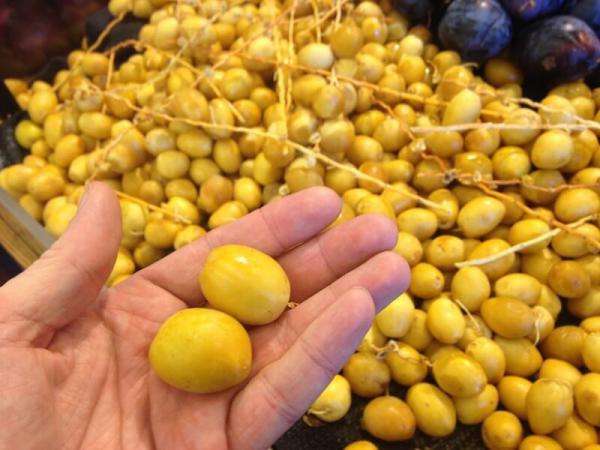 Barhi dates are attached to their vine, and over time turn a brownish color as they ripen, becoming soft and chewy with a thin crisp outer skin. We recommend storing the fruit in cool refrigerated temperatures.
Barhi dates are attached to their vine, and over time turn a brownish color as they ripen, becoming soft and chewy with a thin crisp outer skin. We recommend storing the fruit in cool refrigerated temperatures.
Dates are normally classified as soft, semi-dry or dry. There are many varieties of dates but they all go through four stages of development. Chimri is the first stage and lasts for a period of 17 weeks, followed by a six-week period called the Khalal stage. These are the stages of growing from pollination to full size. The last two stages of rotab , a four-week stage of ripening, and the Tamar, stage when they are fully ripe. Dates are harvested during one of the last two stages, depending on the variety, and preserved by cold storage.
Place dry dates in the refrigerator to keep them for eating or using in recipes within the next few months. Dry dates will keep for two or three months with no refrigeration, but will last up to eight months in the refrigerator. Soft dates will not last quite as long. Freeze dates to preserve for later use. Slightly unripe dates will last a few months longer than fully ripe dates, but they will both last for over a year. Cut date pieces to a desired shape or size and place in a fruit dehydrator. Once dehydrated, place the dates in a storage container. They do not need to be refrigerated and will last up to a month or two.
When Buying Date, Consider 3 Points
If you are going to buy fresh or dried dates, pay attention to the following points:
- Choose dates that have a thin skin. Smell the dates so that they do not smell bad and sour. One of the signs of old dates is its sugar content. Buy dates that do not show any sugar grains on the surface or in the juice.The shelf-life is equivalent to how long the fruit is good for until it can no longer be eaten. The yellow Barhi dates have a short shelf-life, where they are only good for a few days if left out, or a few weeks if they are kept in the refrigerator. If not, they will not last as long.
- If you are new to this field, do not go for open dates because it is not clear under what conditions these dates were grown and transported. When buying packaged dates, make sure that the dates are not pressed and do not stick together. Make sure that the packaging does not contain deep objects such as plants or small debris.
- Each type of date has its own color, so know the type of date and know what color each date should be. To determine the freshness of dates, one should not pay attention to whether they are wrinkles or not, because some types of dates naturally have wrinkles on the surface of their skin.
Distributing yellow Dates in Different Packing
 After being harvested, the large date clusters are then sorted through and either packed in the field or in a separate packing house. In this case, you will see that the difference between the two is if the customer wants the dates still on the vine or individualized and washed.
After being harvested, the large date clusters are then sorted through and either packed in the field or in a separate packing house. In this case, you will see that the difference between the two is if the customer wants the dates still on the vine or individualized and washed.
With a good package, you can store dates in the freezer for up to 3 years. When you take the dates out of the freezer, do not consume them at all if you encounter an unpleasant taste or smell. The longer it is stored, the less flavor it will have. Long-term storage of dates causes leachate to collect at the bottom of the container and the shape of the date becomes ugly. After storage dates, after a while, the moisture dries on it, and this drying of the moisture causes spots on the skin of the date, which is called crystallization of date sugar (nectar). This is perfectly normal and you can melt these sugar crystals by heating it a little.
Producing Yellow Dates Varieties
Many types of yellow dates that are grown are characterized as soft and semi-soft, with the semi-soft always needing to be hand harvested. A common example of the semi-soft varieties is the medjool dates. In addition to those two categories, there is the Barhi date that has an additional harvest and is harvested yellow and unripe to reach a different audience. There is a common misconception that dates are dried, but that is really just how they ripen on the tree. There is no drying on the ground or machine drying. When harvested fresh and ripe, they have wrinkly skin and are soft to the touch. However, if left for extra time on the tree, the dates do get firmer and have more wrinkles on their skin.
Buying Yellow Dates at the Good Price
 We offer best quality yellow dates in our center. Our company will supply you wonderful dates. Our product has significant health, safety and environmental advantages over natural products. Our company provides high quality dates from valuable trees in the Middle East. Our specialists will help you easily get the date you need in your desired packaging with the suitable price. To get more information about yellow dates, you can Contact us.
We offer best quality yellow dates in our center. Our company will supply you wonderful dates. Our product has significant health, safety and environmental advantages over natural products. Our company provides high quality dates from valuable trees in the Middle East. Our specialists will help you easily get the date you need in your desired packaging with the suitable price. To get more information about yellow dates, you can Contact us.






